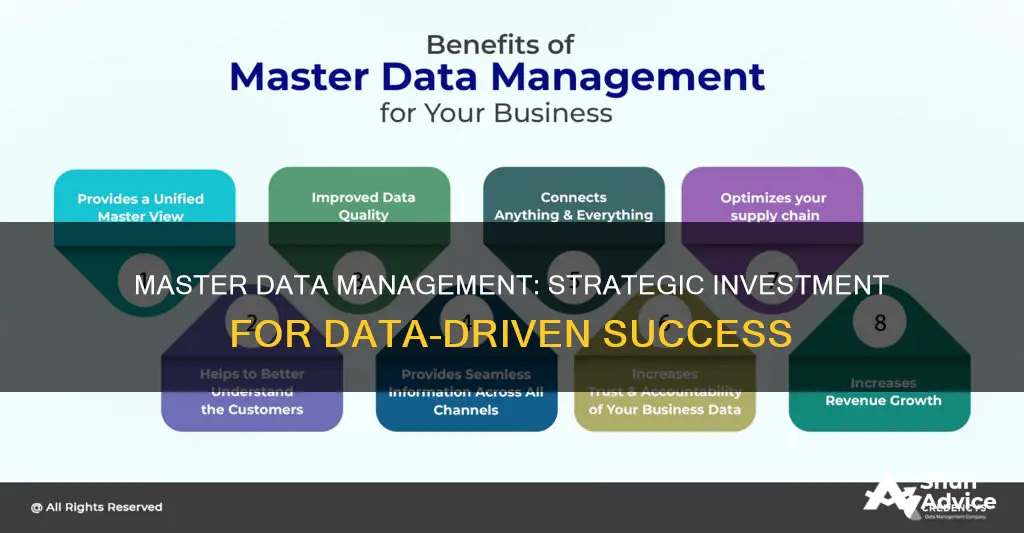
Master Data Management (MDM) is a critical investment for businesses aiming to streamline their data processes and leverage data as a strategic asset. MDM provides a single source of truth for an organization's data, ensuring consistency, accuracy, and reliability. By consolidating data from various sources, MDM helps businesses make informed decisions, improve operational efficiency, enhance customer relationships, and drive innovation.
MDM offers a comprehensive approach to data management, going beyond traditional data handling methods. It involves technology, governance, processes, and people to create a trusted view of critical data. MDM ensures data is cleansed, transformed, and integrated effectively, providing a unified point of reference for key entities such as customers, products, suppliers, and employees.
The benefits of MDM are significant and far-reaching. It enhances decision-making by providing consistent and high-quality data. It streamlines operations by eliminating data discrepancies, reducing costs, and improving agility. MDM also plays a crucial role in regulatory compliance, data security, and collaboration across departments.
Additionally, MDM boosts revenue and improves customer satisfaction by enabling personalized interactions and accurate insights. With MDM, businesses can gain a competitive edge, improve their data-driven strategies, and ultimately, drive business success.
In today's data-centric business landscape, MDM is no longer a luxury but a necessity for organizations aiming to harness the full potential of their data.
| Characteristics | Values |
|---|---|
| Enhanced decision-making | Master Data Management (MDM) provides a single, authoritative view of data, enabling companies to obtain actionable insights and improve business performance. |
| Improved data quality | MDM improves data accuracy, completeness, and reliability by cleaning, standardizing, and de-duplicating data. |
| Increased operational efficiency | MDM streamlines data management processes by automating data collection, integration, and delivery, resulting in reduced time and labor costs. |
| Compliance and risk management | MDM helps maintain compliance with data regulations by tracking data lineage and maintaining historical records, reducing the risk of non-compliance penalties. |
| Better customer service | MDM enables a 360-degree view of customer data, enhancing customer profiling, segmentation, and satisfaction. |
| Reduced IT costs | MDM eliminates data redundancy and streamlines data management, leading to significant cuts in IT costs. |
| Increased revenue | MDM helps identify and leverage opportunities, resulting in higher revenue for businesses. |
| Productivity enhancement | MDM facilitates easier access to data, saving employees time and improving productivity. |
| Strengthened data security | MDM enhances data security by implementing consistent security policies and central data control across the enterprise. |
| Greater business agility | MDM provides a clear, unified view of data, allowing companies to respond faster to market changes. |
What You'll Learn
- Enhanced decision-making: MDM provides a single, authoritative view of data, enabling companies to obtain actionable insights and improve business performance
- Improved data quality: MDM software can clean, standardise and de-duplicate data, enhancing accuracy, completeness and reliability
- Increased operational efficiency: MDM streamlines data management processes by automating data collection, integration and delivery, saving time and reducing labour costs
- Compliance and risk management: MDM helps companies maintain compliance by tracking data lineage and maintaining historical records, reducing the risk of non-compliance penalties
- Better customer service: MDM enables a 360-degree view of customer data, enhancing customer profiling, segmentation and satisfaction

Enhanced decision-making: MDM provides a single, authoritative view of data, enabling companies to obtain actionable insights and improve business performance
Enhanced Decision-Making with Master Data Management
Master Data Management (MDM) is a powerful tool that provides a single, authoritative view of data, driving enhanced decision-making and improved business performance. MDM serves as a trusted guide, helping organizations navigate the complex world of data by creating a unified, coherent master record for each critical entity. This includes customers, products, suppliers, and employees, ensuring everyone operates with the same up-to-date information.
Benefits of MDM for Decision-Making
MDM brings numerous advantages that directly impact decision-making processes:
- Data Consistency: MDM ensures data consistency across departments, reducing errors and misunderstandings and promoting a unified organizational direction.
- Enhanced Data Quality: MDM improves data accuracy by eliminating redundancies and rectifying inaccuracies, leading to more reliable outcomes and increased trust in data-driven strategies.
- Streamlined Operations: MDM streamlines operations by providing a single version of the truth, making processes faster, smoother, and more efficient, thus reducing operational costs and improving agility.
- Improved Decision-Making: MDM provides consistent, high-quality data, enabling better, more informed decisions and a strategic edge in the marketplace.
- Enhanced Customer Experience: MDM offers a unified view of customer data, allowing for personalized interactions, improved customer support, and enhanced customer satisfaction.
- Agility in Innovation: MDM provides a clear view of market trends and customer behaviors, enabling businesses to adapt and innovate quickly.
- Risk Management: MDM provides reliable, consistent data for forecasting potential risks, such as market downturns, new competitors, or changing consumer preferences.
MDM's Impact on Business Performance
The benefits of MDM extend beyond decision-making, positively influencing overall business performance:
- Increased Revenue: MDM improves data quality and consistency, leading to sharper targeting, more accurate segmentation, and enhanced sales and marketing campaigns, resulting in increased revenue streams.
- Cost Savings: MDM reduces costs by eliminating data redundancy, improving operational efficiency, and minimizing error rectification expenses and data management overheads.
- Regulatory Compliance: MDM aids in meeting regulatory standards, reducing the risk of penalties and enhancing the organization's reputation.
- Improved Collaboration: MDM breaks down data silos, ensuring that all units operate with the same dataset, fostering better inter-departmental collaboration and holistic strategies.
- Efficient Data Governance: MDM ensures data evolution does not compromise quality, consistency, or reliability, providing robust frameworks and governance structures.
- Better Integration with Third-Party Systems: MDM simplifies integration with external systems, reducing integration errors and ensuring efficient data exchanges.
In conclusion, MDM empowers organizations to make informed decisions, improve business performance, and navigate the complex digital landscape successfully. By investing in MDM, businesses can harness the full potential of their data, leading to enhanced operations and strategic growth.
Portfolio Investing: A Smart Approach for Wise Investors
You may want to see also

Improved data quality: MDM software can clean, standardise and de-duplicate data, enhancing accuracy, completeness and reliability
Master Data Management (MDM) is a technology, tools and processes that ensure master data is coordinated across the enterprise. MDM software can clean, standardise, and de-duplicate data, enhancing accuracy, completeness, and reliability.
Cleaning and Standardising Data
Before cleaning and standardising data, it is crucial to understand the data model for the master data. This involves defining the contents of each attribute and mapping them from the source system to the master data model. The following are some typical data cleansing functions:
- Normalising data formats: Ensuring consistency in formats such as phone numbers, addresses, etc.
- Replacing missing values: Filling in missing information by inserting defaults or looking up relevant data such as ZIP codes or addresses.
- Standardising values: Converting measurements, prices, or part numbers to a common standard or currency.
- Mapping attributes: Parsing and rearranging data to fit the standard format, such as separating first and last names or rearranging data elements into a standard order.
De-duplicating Data
A core function of MDM software is deduplication, which involves matching master data records across the enterprise that describe the same entity, such as a person, organisation, product, or asset. The process includes linking these records, often through a "golden record," and applying them to a hierarchy.
MDM software uses data matching techniques to identify duplicates, with more advanced solutions capable of identifying the same organisation or product across different records. Data matching can also be used to match against external registries, enriching internal records and further aiding in duplicate identification.
Once duplicate records are confirmed, MDM software offers various approaches to handle the data:
- Registry MDM Style: Storing only the IDs of the linked records for specific operational and analytic purposes.
- Survivor Record: Choosing the best-fit record as the survivor and retaining the IDs of purged records for reference.
- Golden Record: Forming a compiled record from the best-fit data elements and storing it in the MDM hub, while also retaining the IDs of linked records.
- Dynamic Compilation: Keeping the sourced records in the MDM hub and dynamically compiling a golden view for a specific purpose when needed.
National Savings and Investments: A Secure Financial Future
You may want to see also

Increased operational efficiency: MDM streamlines data management processes by automating data collection, integration and delivery, saving time and reducing labour costs
MDM, or Master Data Management, is a technology, tool, and process that ensures master data is coordinated across an enterprise. MDM automates data collection, integration, and delivery, saving time and reducing labour costs. This automation streamlines data management processes, increasing operational efficiency.
MDM's automation capabilities extend to data integration, reconciliation, enrichment, quality, and governance. It uses automation and AI to identify, match, and merge data across systems, and then shares the clean data with the relevant applications, systems, and analytics. MDM can also correct inconsistencies in records, capture data sources, and create an audit trail of changes.
The automation of these processes saves time and reduces the need for manual labour, increasing efficiency and reducing costs. This efficiency also leads to quicker responses to market dynamics, ensuring a business remains agile and responsive. MDM's automation capabilities also improve data security by implementing consistent security policies across the enterprise.
Fiduciary Investment Management: Understanding the Basics
You may want to see also

Compliance and risk management: MDM helps companies maintain compliance by tracking data lineage and maintaining historical records, reducing the risk of non-compliance penalties
Compliance and risk management are key considerations for any business, and master data management (MDM) offers a robust solution for maintaining regulatory compliance and reducing the risk of penalties. MDM helps companies navigate the complex world of data compliance by ensuring data integrity and adherence to standards and regulations.
MDM creates a single, coherent master record for each entity in an organization, such as customers, products, suppliers, and employees. This master record, also known as a "golden record," contains essential information that is consistent, reliable, and up-to-date. By consolidating data from various sources, MDM eliminates data silos, where different departments maintain conflicting versions of the same data. This harmonization ensures that everyone in the organization operates with the same information, reducing errors and misunderstandings.
The benefits of MDM in compliance and risk management are significant. Firstly, MDM helps organizations comply with industry standards and regulations by ensuring that master data is accurately recorded, maintained, and audited. This includes meeting stringent data management practices required by regulatory bodies. Secondly, MDM reduces the risk of non-compliance penalties by providing a transparent framework for data governance. The creation of master records involves data integration, reconciliation, enrichment, and quality assurance processes, resulting in clean and consistent data that meets regulatory standards.
Additionally, MDM improves data security by centralizing data management. This makes it easier to monitor access and implement uniform security protocols, protecting sensitive and critical data. MDM also enables data lineage tracking and maintains historical records, providing an audit trail of changes made to the data. This transparency enhances trust in the data's integrity and helps organizations demonstrate compliance with regulatory requirements.
Moreover, MDM enhances risk management capabilities by providing reliable and consistent data. Organizations can use MDM to forecast potential risks, such as market downturns, new competitors, or changing consumer preferences. This proactive approach allows for informed and preemptive action, reducing the impact of potential risks on the business.
In conclusion, MDM is a powerful tool for compliance and risk management. By ensuring data accuracy, consistency, and transparency, MDM helps organizations maintain regulatory compliance and reduce the risk of penalties. With MDM, companies can navigate the complex world of data with confidence and make informed decisions while protecting their reputation and avoiding costly fines.
Creating Investment Portfolio Projections: A Comprehensive Guide
You may want to see also

Better customer service: MDM enables a 360-degree view of customer data, enhancing customer profiling, segmentation and satisfaction
Master Data Management (MDM) is a powerful tool for businesses to improve their understanding of customers and enhance their overall satisfaction. By creating a single, unified view of customer data, MDM empowers businesses to deliver better customer service and make more informed decisions. This 360-degree view involves aggregating data from various touchpoints and sources, including interactions with different departments, products and services, and even historical data. This comprehensive approach allows businesses to truly understand their customers' preferences, behaviours, and needs.
One of the key advantages of MDM is its ability to provide a holistic view of the customer. By connecting data from multiple sources, businesses can gain insights into customer profiles, including their purchase history, preferences, and interactions with the company. This enables businesses to segment their customers effectively, allowing for more precise marketing and sales strategies. With MDM, businesses can identify their most profitable customers, cross-selling and up-selling opportunities, and design engaging experiences to attract and retain customers.
MDM also improves data accuracy and consistency, ensuring that businesses make decisions based on reliable and up-to-date information. By eliminating data silos and discrepancies, MDM ensures that all departments work with the same data set, reducing errors and misunderstandings. This promotes a unified direction for the business, aligning goals and strategies across the organisation. Furthermore, MDM can help streamline customer support by providing a comprehensive view of the customer's journey, past interactions, and issues, leading to quicker resolutions and enhanced customer satisfaction.
Additionally, MDM enables businesses to make accurate product recommendations by analysing consolidated customer data, including purchase history, preferences, and behaviours. This not only boosts sales but also enhances the overall shopping experience for customers. MDM also aids in efficient customer segmentation, ensuring that marketing campaigns are laser-focused and resonate strongly with the target audience.
In today's digital age, where data security is of utmost importance, MDM emphasises robust data governance. By centralising data management, MDM makes it easier to monitor access and implement uniform security protocols, protecting sensitive customer information. This enhances customer trust and deepens their relationship with the brand.
Overall, MDM empowers businesses to deliver better customer service, make more informed decisions, and ultimately enhance customer satisfaction and loyalty. By leveraging MDM to gain a 360-degree view of their customers, businesses can design personalised experiences, improve engagement, and build long-lasting relationships with their customers.
Balancing Your Investment Portfolio: Strategies for Success
You may want to see also
Frequently asked questions
Master data management (MDM) provides a 360-degree view of customer data, allowing businesses to tailor interactions and improve customer satisfaction. It also enables businesses to make accurate product recommendations and efficient customer segmentation, ultimately enhancing the customer experience.
MDM simplifies workflows by centralizing and streamlining data processes, eliminating redundancies, reducing manual tasks, and automating data-related tasks. This leads to improved operational efficiency and reduced costs.
MDM enables self-service data access, allowing employees to easily access the data they need without relying on IT or data specialists. This saves time, improves productivity, and enables employees to make informed decisions.
MDM provides a 360-degree view of data across the enterprise, giving organizations a comprehensive and unified view of their data. This enables faster and more informed decision-making, helping businesses adapt quickly to changing market dynamics and customer needs.







